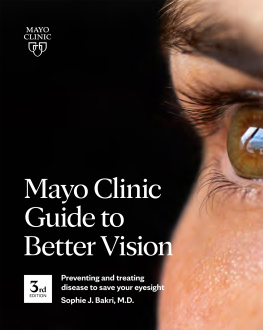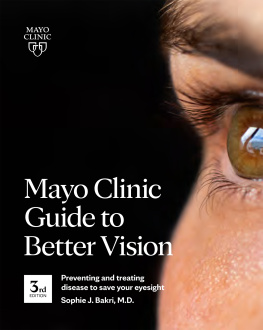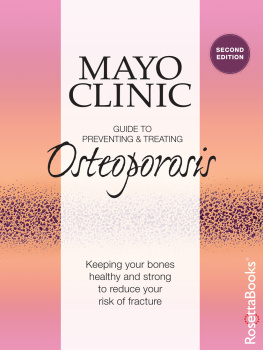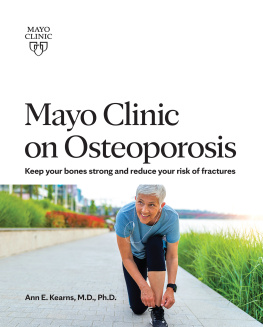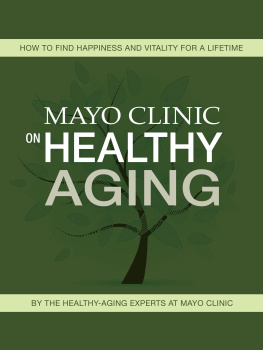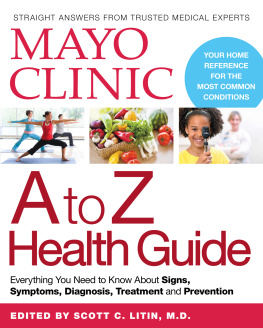
Mayo Clinic
Medical Editor | Sophie J. Bakri, M.D.
Publisher | Daniel J. Harke
Editor in Chief | Nina E. Wiener
Senior Editor | Karen R. Wallevand
Art Director | Stewart J. Koski
Production Design | Darren L. Wendt
Illustration and Photography | Mayo Clinic Medical Illustration and Animation, Mayo Clinic Media Support Services
Editorial Research Librarians | Abbie Y. Brown, Edward (Eddy) S. Morrow Jr., Erika A. Riggin, Katherine (Katie) J. Warner
Copy Editors | Miranda M. Attlesey, Alison K. Baker, Nancy J. Jacoby, Julie M. Maas
Indexer | Steve Rath
Contributing Editors and Writers | Heather L. LaBruna; Michael A. Mahr, M.D.; Brian G. Mohney, M.D.; Miguel E. Mulet, Jr., M.D.; Cherie B. Nau, O.D.; Gavin W. Roddy, M.D., Ph.D.; Alaina L. Softing Hataye, O.D.
Image Credits | The individuals pictured are models, and the photos are used for illustrative purposes only. Theres no correlation between the individuals portrayed and the condition or subject discussed. All photographs and illustrations are copyright of MFMER except for the following: NAME: shutterstock_1850236840/PAGE: Cover/CREDIT: SHUTTERSTOCK NAME: 160961108/PAGE: 21/CREDIT: ISTOCK/CATHERINE YEULET/THINKSTOCK NAME: shutterstock_708508210/PAGE: 33/CREDIT: SHUTTERSTOCK NAME: shutterstock_708508210/PAGE: 61/CREDIT: SHUTTERSTOCK NAME:shutterstock_708508210/PAGE: 95/CREDIT: SHUTTERSTOCK NAME: shutterstock_708508210/PAGE: 113/CREDIT: SHUTTERSTOCK
Published by Mayo Clinic Press
2021 Mayo Foundation for Medical Education and Research (MFMER)
MAYO, MAYO CLINIC and the Mayo triple-shield logo are marks of Mayo Foundation for Medical Education and Research. All rights reserved. No part of this book may be reproduced, stored in a retrieval system, or transmitted, in any form or by any means, electronic, mechanical, photocopying, recording or otherwise, without the prior written permission of the publisher.
The information in the book is true and complete to the best or our knowledge. This book is intended only as an informative guide for those wishing to learn more about health issues. It is not intended to replace, countermand or conflict with advice given to you by your own physician. The ultimate decision concerning your care should be made between you and your doctor. Information in this book is offered with no guarantees. The author and publisher disclaim all liability in connection with this book.
For bulk sales to employers, member groups and health-related companies, contact Mayo Clinic, 200 First St. SW, Rochester, MN 55905 or email .
ISBN 978-1-893005-73-0
Library of Congress Control Number: 2021937317
Some images within this content were created prior to the COVID-19 pandemic and may not demonstrate proper pandemic protocols. Please follow all recommended CDC guidelines for masking and social distancing.
Contents
Preface
Think about how much you depend on your eyes for almost everything that you do, whether its picking out clothes to wear, preparing a meal, driving a car, reading the mail, or using a cellphone, tablet or computer. These daily tasks help maintain your overall well-being and quality of life. So, keeping your eyes healthy and preserving your vision are critical lifetime investments!
Millions of Americans depend on eyewear to correct their vision so that they can see better, resulting in billions of dollars spent each year on eyeglasses and contact lenses. Still, visual impairment can, and does, occur. Dangers to vision include common conditions such as age-related macular degeneration, glaucoma, diabetic retinopathy and cataracts. Accidental eye injuries also can lead to vision loss.
Mayo Clinic Guide to Better Vision, Third Edition is based on the experience and advice of Mayo Clinic specialists in eye health. It provides practical, up-to-date information on some of the most common eye diseases, as well as tips on how to recognize early symptoms and key factors to help you make an informed decision regarding treatment.
The book is written in a clear, conversational style, supported by illustrations, photographs and evidence-based medicine. Its a practical resource for protecting your eyesight keeping your eyes healthy and your vision sharp at any age.
Sophie J. Bakri, M.D.
Medical Editor

Sophie J. Bakri, M.D., is the chair of the Department of Ophthalmology at Mayo Clinic in Rochester, Minn., and the Whitney and Betty MacMillan Professor of Ophthalmology at Mayo Clinic College of Medicine and Science, an award made in honor of Robert R. Waller, M.D. Dr. Bakri specializes in diseases of the retina and vitreous, in particular, age-related macular degeneration, diabetic retinopathy and complex retinal detachments, including the surgical treatment of these conditions. She has authored more than 180 peer-reviewed papers and book chapters and has served as the principal investigator on numerous clinical trials involving medications to treat retinal disease. Dr. Bakri has received a Senior Achievement Award from the American Academy of Ophthalmology and a Senior Honor Award and Young Investigator Award from the American Society of Retina Specialists.
Chapter 1 A look inside
For being such a small part of your body, your eyes play an exceptional role in your life. Each eyeball is about an inch in diameter, just a little smaller than the ball used in table tennis. The vision your eyes provide helps you experience the shapes, colors and motions of your surroundings. It stimulates your creativity and appreciation of beauty. It alerts you to danger and the unexpected. You rely on vision to explore, develop, learn and much more.
All five senses are important to you, but sight is the sense you may trust the most when performing many routine activities. With the help of your eyes, you prepare meals, select clothes to wear, read books, write notes, balance bank accounts, drive cars, run errands, perform your job, surf the internet, watch television and enjoy the theater. On an emotional level, vision helps define your self-image and how you interact with others. The author Henry David Thoreau expressed the value of sight succinctly, We are as much as we see.
Given how much you depend on your sight every day, its essential to keep your eyes as healthy as you can.
Parts of the eye
People often compare the parts of the eye to those of a camera, and there are certain similarities. Like a camera, each eyeball allows light to enter its interior through an adjustable opening at the front. An internal lens focuses the light onto a layer of light-sensitive cells at the back of the eyeball, similar to the light-sensitive film used in the camera.
This comparison, however, doesnt do your eyes justice. They have a far more complex, sophisticated function than a camera, or any other piece of technology for that matter. Its not just one but two eyes were talking about, performing as a perfectly synchronized pair. The materials that make up your eyeballs are extremely flexible, resilient, functional and lightweight.
Each eyeball autoregulates many rapid adjustments for brightness, focus and internal pressure. Light striking the back of the eyeball induces chemical reactions in the photosensitive cells that generate electrical impulses. These impulses trigger two-way communication between your eyes and an optical command center in your brain.
Next page
